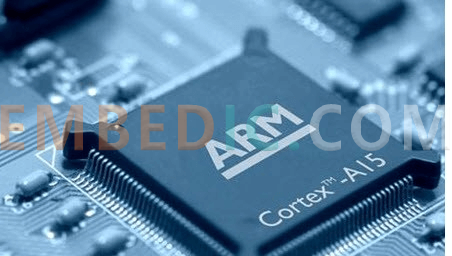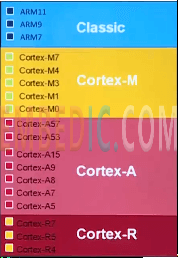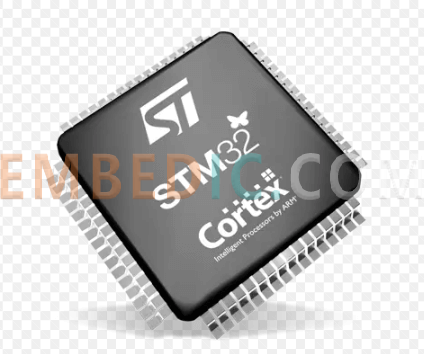Microcontroller engineers often need to make microcontroller selections when they are developing projects, and choose the right microcontroller according to the functional requirements of the project. This requires a good understanding of the features and advantages of each microcontroller, and what is the difference between ARM and STM32 microcontroller as two common types of microcontrollers?

ARM: It means Advanced RISC Machines. The Advanced Streamlined Instruction Set microprocessor.
It has several layers of meaning:
1. ARM is a company, a British company. It only sells technology licenses for chips.
2. ARM is the world's leading 32-bit embedded RISC chip core design company, RISC - Streamlined Instruction Set Computer, characterized by the format of all instructions are the same, all instructions are the same instruction cycle; ARM itself does not produce and sell chips, the world's top chip manufacturing companies, such as Actel, TI, ST, Fujitsu, NXP, etc. are purchased. The world's top chip manufacturing companies, such as Actel, TI, ST, Fujitsu, NXP, etc., all buy ARM's cores and combine their technical advantages to produce and sell them.
3. ARM is a core, not a chip as we usually see it.
The architecture of the ARM core has gone through six versions: V1-V6

ARM9, ARM10 corresponds to V5 architecture, ARM11 corresponds to V6 architecture, clock frequency is 350-500Mhz, up to 1Ghz.
STM32 microcontroller is a 32bit series of microcontrollers produced by ST (STMicroelectronics) based on ARM's cortex-M3 as the core.

ST - STMicroelectronics (a company name), that is, SOC manufacturers
Here to expand:
A chip such as STM32 has a core (ARM), and the core ARM is produced by ARM (IP vendor), and the peripherals are produced by ST (SOC vendor).
Peripherals are produced by ST (SOC vendor), and on top of that, various peripherals are added, such as GPIO, I^2C, etc.
M - Microelectronics abbreviation that is, the microcontroller
Note: Microprocessors have MMU - Memory Management Unit on the basis of the microcontroller, general microcontrollers
does not run the system, the program written for bare-metal routines.
32 - 32bit, indicating that it is a 32bit microcontroller (microcontroller bits refers to the width of the data processed by the CPU,
The data bus width of a 32-bit microcontroller is 32 bits.
(Usually can directly handle 8-bit or 16-bit or 32-bit data.)
STM32 classification
CPU bits Core Series
Further Reading: Introduction to STM32 Minimum System in Detail 2022
Yes.
ARM is a kind of microcontroller, 51 is also, but arm ROM and RAM is much larger than 51, and IO port function and processing speed is also two levels, arm can be on many operating systems, 51 can only barely on the extremely simple real-time operating system, so arm is often used to develop cell phones and other multimedia products, 51 can only complete a limited real-time control functions, image a little, 51 and The difference in level between 51 and arm is like the difference in level between a cell phone and a personal computer.
1. Software
This should be the biggest difference, the introduction of the operating system, why the introduction of the operating system? What are the benefits?
(1) Convenience: mainly in the later development, that is, in the operating system directly develop applications. Not like the microcontroller everything has to be rewritten. The front end of the operating system porting work, or professionals to do.
2) Safety: This is a feature of LINUX. the kernel of LINUX is separate from the user space memory management, so that no single program error by the user will cause the system to die. This has not been seen in software development for microcontrollers.
3) Efficient: The introduction of a process management scheduling system makes the system run more efficiently. In the traditional microcontroller development is mostly based on interrupt-based front and backend technology, which has limitations on the management of multitasking.
2. Hardware
Now the 8-bit microcontroller technology hardware development is also very fast, there are also many very powerful microcontroller. But compared with 32ARM is still some gap, ARM chip most of the SDRAM, LCD and other controllers integrated into the chip. In the 8-bit machine, most of them have to be extensible. In general, the microcontroller is a microcontroller, ARM is obviously a microprocessor already.
1. Product definition
ARM microcontroller is the first RISC microprocessor with low power consumption and cost designed by Acorn Ltd. in the UK; STM32 microcontroller is an ARM Cortex-M0, M0+, M3, M4 and M7 core designed for embedded applications requiring high performance, low cost and low power consumption.
2. Product features
ARM microcontroller's Jazelle technology enables Java acceleration to get much higher performance than the software-based Java Virtual Machine (JVM) and 80% lower power consumption compared to equivalent non-Java accelerated cores; STM32 microcontroller's ARM 32-bit Cortex-M3 CPU with a maximum operating frequency of 72MHz, 1.25DMIPS/MHz. single cycle Multiplication and hardware division.
3. The product advantages
ARM microcontroller small size, low power consumption, low cost, high performance; supports Thumb (16-bit) / ARM (32-bit) dual instruction set, can be well compatible with 8-bit / 16-bit devices; extensive use of registers, faster instruction execution; STM32 microcontroller integrated embedded Flash and SRAM memory of the ARM Cortex-M3 core. Compared to 8/16-bit devices, the ARM Cortex-M3 32-bit RISC processor offers higher code efficiency. STM32F103xx microcontrollers come with an embedded ARM core, so they are compatible with all ARM tools and software.
Manufacturer: Texas Instruments
IC DSP FIX/FLOAT POINT 841FCBGA
Product Categories: DSP
Lifecycle:
RoHS:
Manufacturer: Texas Instruments
IC DSP FIXED-POINT 361NFBGA
Product Categories: DSP
Lifecycle:
RoHS:
Manufacturer: Texas Instruments
IC DSP FIX/FLOAT POINT 841FCBGA
Product Categories: DSP
Lifecycle:
RoHS:
Manufacturer: Analog Devices
IC DSP 12BIT 400MHZ 120LQFP
Product Categories: DSP
Lifecycle:
RoHS:
Looking forward to your comment
Comment